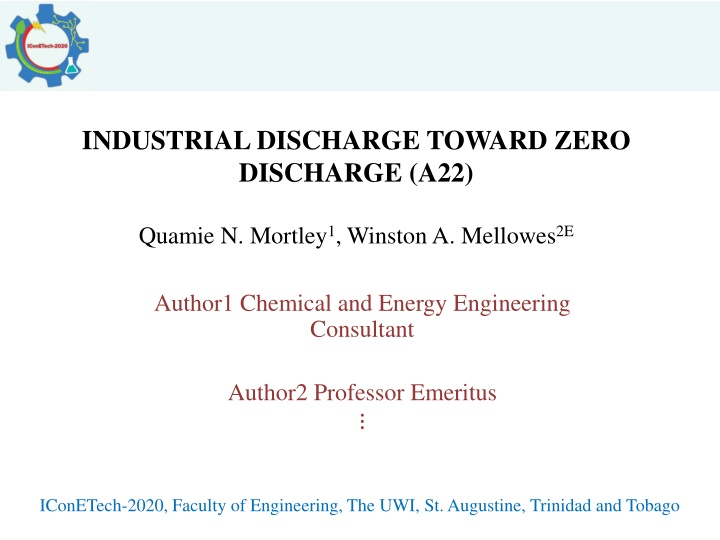
Innovative Approach to Industrial Discharge Reduction
Discover how a unique engineering approach utilizing thermodynamic modeling was used to minimize organic discharge in the alumina production process, leading to significant cost savings and environmental benefits. By analyzing the partitioning of volatile compounds in condensate, this study offers a sustainable solution to the challenges faced by the industry.
Download Presentation

Please find below an Image/Link to download the presentation.
The content on the website is provided AS IS for your information and personal use only. It may not be sold, licensed, or shared on other websites without obtaining consent from the author. If you encounter any issues during the download, it is possible that the publisher has removed the file from their server.
You are allowed to download the files provided on this website for personal or commercial use, subject to the condition that they are used lawfully. All files are the property of their respective owners.
The content on the website is provided AS IS for your information and personal use only. It may not be sold, licensed, or shared on other websites without obtaining consent from the author.
E N D
Presentation Transcript
INDUSTRIAL DISCHARGE TOWARD ZERO DISCHARGE (A22) Quamie N. Mortley1, Winston A. Mellowes2E Author1 Chemical and Energy Engineering Consultant Author2 Professor Emeritus IConETech-2020, Faculty of Engineering, The UWI, St. Augustine, Trinidad and Tobago
INTRODUCTION Alumina is produced from bauxite ore, using the Bayer process at a Jamaican refinery. The process includes the digestion of bauxite with sodium hydroxide at 135 oC, hence the requirement for both steam and power. In the course of this extraction, large quantities (>350 m3 /h) of digester condensate are produced. This regenerative condensate is cooled, neutralized and discharged from the site to the environment. Well water abstraction is restricted by the Water Resource Authority, there is a requirement for minimized liquid discharge of wastewater, and high cost of energy necessitated using the condensate. Removal of Total Organic Carbon (TOC) prevented re-use as boiler feedwater, with an attached US$10 million cost for the removal of TOC. IConETech-2020, Faculty of Engineering, The UWI, St. Augustine, Trinidad and Tobago
OBJECTIVES Given the required capital outlay for treating water and condensate contaminated with organics, a new approach was required. An engineering approach was used. Thermodynamic modelling of hydrometallurgical processes was used. This area of study include the partitioning of volatile compounds among process liquors, steam and condensates in a train of flash vessels, the development of thermodynamically consistent models for organic impurities in Bayer liquors, and the prediction of their mixing properties with major liquor components. Determine how much organics is portioning in the condensate. IConETech-2020, Faculty of Engineering, The UWI, St. Augustine, Trinidad and Tobago
METHODOLOGY Figure 1- The liquor enters the first flash vessel from the digester, passes through the subsequent flash vessels operating at successively lower pressures, and is eventually cooled down to boiling temperature at atmospheric pressure. The methodology used was to collect condensate generated at each flash tank by depressurization and investigate the amount of organics portioning in the condensate. IConETech-2020, Faculty of Engineering, The UWI, St. Augustine, Trinidad and Tobago
RESULTS Figure 2 - Relative amounts of selected volatiles in liquor ( ), steam ( ), and condensate ( ) from analysis of a train of flash vessels in a Bayer plant. The organics in condensate is reduced along the train. IConETech-2020, Faculty of Engineering, The UWI, St. Augustine, Trinidad and Tobago
RESULTS Table 1 Digester Condensate Chemical Analysis Constituents Units Digester 1 Digester 2 BFW Boiler Water 3800 40 pH Conductivity P Alkalinity M Alkalinity Sulphur Chloride Calcium Magnesium Total Hardness Copper Iron Sodium Phosphate Silica Ammonia Free Aluminum Oily Matter Non-Volatile TOC TOC Units mhos 166 mg/l mg/l mg/l mg/l mg/l mg/l mg/l mg/l mg/l mg/l mg/l mg/l mg/l mg/l mg/l mg/l mg/l 10.3 10.3 112 147 187 <0.5 0.5 0.13 0.1 0.13 0.002 0.014 0.9 <0.4 0.07 40 0.7 0.0 44 0.2 0.2 0.03 0.5 0.5 159 215 <0.5 0.5 0.02 <0.1 <0.02 <0.002 <0.002 14.4 <0.4 0.11 46 0.6 0.0 57 IConETech-2020, Faculty of Engineering, The UWI, St. Augustine, Trinidad and
RESULTS Condensate fit for use as 600 psig boiler feedwater. 3,066,000 m3/year of wastewater removed from the environment. Avoided cost for water treatment US$10,000,000. Fuel Savings US$3,000,000/year. No capital expenditure. UWI Engineering in action. IConETech-2020, Faculty of Engineering, The UWI, St. Augustine, Trinidad and Tobago
REFERENCES [1] Konigsberger, E. 2010. Thermodynamics of Impurities in Hydrometallurgical Processes, 14th International Symposium on Solubility Phenomena and Related Equilibrium Processes, Leoben, Austria, (25-30 July 2010). [2] Clapp, C.E, Hayes, M.H.B. Sizes and Shapes of Humic Substances, Soil Science 164 (1999). [3] Mullett, M., et al. Removal of Mercury from an Alumina Refinery Aqueous Stream, Journal of Hazardous Materials, 144 (2007). [4] Personal communication with GE Betz (now Suez Water Management), Trevose, Pennsylvania, United States, who carried out the water analyses. IConETech-2020, Faculty of Engineering, The UWI, St. Augustine, Trinidad and Tobago
THANK YOU! IConETech-2020, Faculty of Engineering, The UWI, St. Augustine, Trinidad and Tobago





















